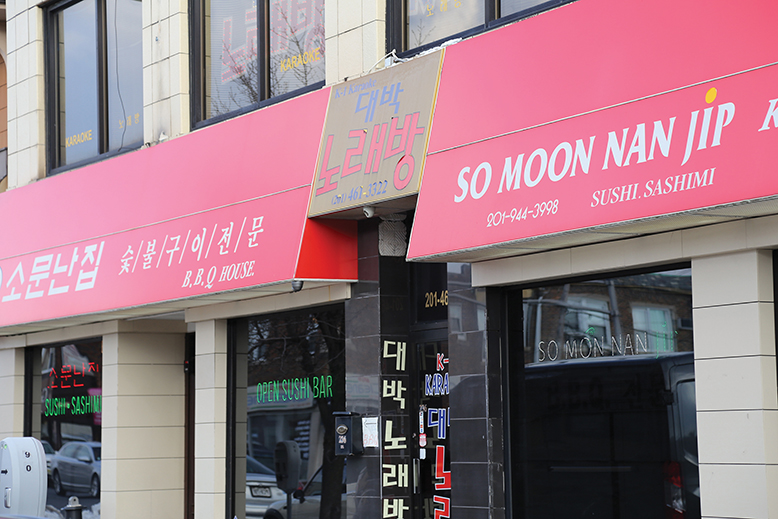
Palisades Park, for many years largely Italian, has in recent decades undergone a dramatic demographic shift. Since at least the 2000 census, this Bergen County town not far from the George Washington Bridge, has had the highest percentage of Korean immigrants and their descendants of any municipality in the country. If you want to explore the dynamic flavors and rustic cooking styles of Korean cuisine, Palisades Park is the place to do it.
Korean barbecue, actually a form of grilling, is the signature style. A brazier is built into the table. Some grills are gas-fired, but the best burn hardwood charcoal, brought to the table in a metal pan by an extremely focused individual wearing fireproof gloves and wielding tongs.
MORE ON GLOBAL EATING:
The Ultimate Guide to Jersey’s Global Restaurant Scene
New Jersey’s 20 Most Underrated Food Markets

Photo by Laura Baer
At the venerable and popular So Moon Nan Jip (238 Broad Avenue, 201-944-3998), the tables are closely spaced, and the charcoal carriers are adept at slithering between them to deliver the hot coals. They cook and serve the meat and seafood as everyone at the table helps themselves to the banchan, the standard accompaniments—bowls of vegetables, pickles, lettuce, condiments and kimchi.
The classic marinated meats are bulgogi (sliced beef) and kalbi (short rib), but there are other choices. One of the tastiest is pork jowl. Its densely marbled fat irresistibly crisps after a few minutes over the coals.
Beyond barbecue, So Moon also offers sushi, sashimi and, best of all, hoe deopbap, a meal-in-a-bowl of salad, sashimi and rice in a mildly spicy chili-vinegar sauce. Beer and sake are available, but try the Korean distilled liquor, soju, clear and bracing at about 20 percent ABV.

A lively display of the Korean barbecue experience at Hanam Korean BBQ House. Photo by Laura Baer
Hanam Korean BBQ House (445 Grand Avenue, 201-482-806; byo), another charcoal grill, is more spacious and has a hipper, younger vibe. It offers pork and tripe, highly marbled American Wagyu beef, and duck from a farm in Pennsylvania. The assortment of banchan is perhaps not as wide as at So Moon, but Hanam will cheerfully refill your favorites.
Aficionados will want to venture about a half mile south of Pal Park to Ridgefield just to indulge in the prized specialty, Korean black goat, at Bang Ga Nae (518 Broad Avenue, 201-941-1199). Thought to have medicinal qualities, black goat, a breed native to Korea, is often accompanied by soju. The goat is steam roasted, yielding a melting texture and a rich flavor somewhere between pork, lamb and pure happiness. Sold by the pound (2-pound minimum), it is offered two ways: jeongol, in a spicy red soup with vegetables and scallions; or suyuk, a haunch your server will break down into boneless morsels on steamed scallions, which you wrap in lettuce with condiments, including gochujang chili paste, aromatic perilla seeds, garlic cloves, jalapeños and tiny salted shrimp.
Some of the most deeply traditional Korean foods are the soups and stews of the countryside. Back in Pal Park, one of the best examples is the spicy pork-neck and potato stew at Tang Maru (500 10th Street, 201-482-8744). Another house specialty is Seolleongtang, a rich ox-bone soup, white from days of simmering. It features sliced beef and rice noodles. Peek in the kitchen window to see the massive bubbling cauldron of stock.
Chinese people began emigrating to Korea in the late 19th century, and over time, a Korean school of Chinese cooking emerged. This is represented at Te Min Quan (270 Broad Avenue, 201-592-8993). The Korean version of mapo tofu is redder and more chili based than the original Szechuan version. The most famous Korean-Chinese dish is jjajangmyun, listed on the English menu here as noodles with Mandarin sauce. It first appeared in 1905 in Inchon, Korea, at a restaurant run by a Chinese immigrant. This version tops thick, springy wheat noodles with a mild, savory black bean purée mixed with crisp chunks of sweet onion and either seafood or cubes of pork.

Sweet potato cake, foreground, and green tea cake from Grand Shilla Bakery. Photo by Laura Baer
For dessert, head to Grand Shilla Bakery (234 Broad Avenue, 201-302-9651) where Sam Kim, the owner, has been working since his mother opened the place (the first Korean bakery in Pal Park) about 30 years ago. Since then, Korean chains have moved in, but Kim wins with quality. He doesn’t settle for commercial sweet red bean paste; he makes his from scratch, simmering it in a giant vat. The effort pays off in the silky texture of his famous boong uh bbang, a fish-shaped pastry filled with red bean paste. Also try some almond cookies. Thin and crisp, they combine the virtues of an Italian pignoli cookie and a potato chip.
